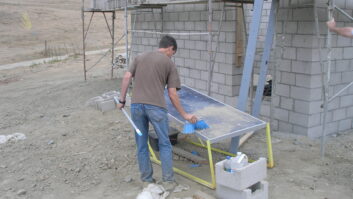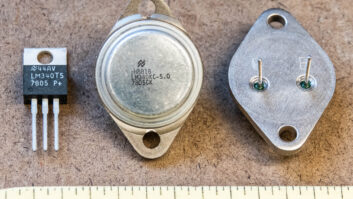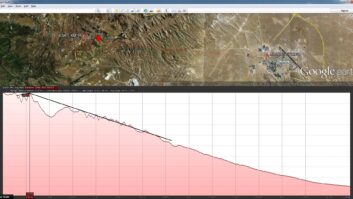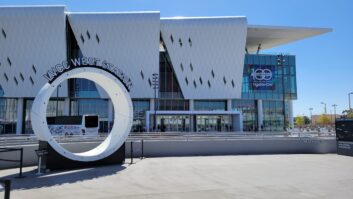The Right Choice in transmitters
Oct 1, 2002 12:00 PM, By Chriss Scherer, editor
Resource Guide

The basic functions of radio broadcasting can be divided into two areas: creation and distribution. The creation process covers the production and on-air elements up to the final audio output. The input to a station’s STL or Web server begins the distribution process. While a station’s operation was long considered to be a singular function, dividing the process into these two areas has become an operational focal point.
There are several factors to keep in mind when it’s time to select a new transmitter. These factors vary by power level, type of service and a station’s individual needs.
Tubes or solid-state?
At one time, high-power applications were limited to tube amplifiers. While solid-state designs are increasing in popularity (and may be the only choice in some cases), tube designs are still functional and reliable. One advantage is that tube designs can be more forgiving with changes in the antenna load from weather or damage.
In the case of an AM transmitter, the only choices from the major U.S. manufacturers are solid-state amplifiers. For FM, there is still a price point that divides the arena. Tube designs can be less expensive at power levels over 5kW, while solid-state designs tend to be cheaper.
The person charged with maintaining a transmitter may have a personal preference for tubes or solid-states based on his experience. Solid-state designs operate at lower voltages than tubes. Younger technicians who are not comfortable with tube designs will likely find greater comfort with transistors than tuned cavities.
For a 10kW solid-state FM transmitter, the added premium over the cost of a tube transmitter is small enough to justify the purchase unless the transmitter is intended for backup use.
In most cases, the additional capital expense for a solid-state design can be offset by the electricity savings and the ongoing maintenance costs. Not only are the transmitters more efficient, they produce less heat, which results in a reduced load to a building’s HVAC system.
A better mouse trap
While the underlying principles of RF transmission have not changed, the methods of creating and controlling a modulated signal have improved. The advances for the AM band have provided cleaner, more reliable transmission methods. About 10 years ago, digital techniques were applied to amplitude modulation when pulse-duration modulation and pulse-width modulation became standard practice.
The latest advance in AM generation is direct digital synthesis, which harnesses the power of digital signal processing to provide better performance and improved distortion specifications.
The most recent improvement for FM exciters came nearly 10 years ago when the first digital exciters were introduced. Once again, digital technology provided a more stable and reliable foundation for generating the RF signal. While the exciter and power amplifier structure of an FM transmitter was always looked at as separate systems working together, the improvements in exciter design extended this view. Stations would take advantage of the incremental upgrade of replacing one of the two parts at a time.
Buying an FM transmitter as a system offers the advantages of integrated features and control. There will most likely be a cost savings as well.
While digital exciters offer several advantages, analog designs are still capable of providing reliable service and a quality signal. They also tend to cost less than their digital counterparts. Regardless of the path chosen, provide power to the exciter through a direct ac feed and not a feed from the transmitter. The ac from the transmitter can suffer from line losses. Additionally, power the exciter through a UPS if possible, particularly if it is a digital exciter. This control can be tied to the interlock string to prevent exciter damage during antenna switching or when the transmitter is turned off.
Size matters
As with any technology, as it advances it tends to decrease in size. The high-powered behemoth transmitters of yesterday are now replaced with one or two racks of equipment. A smaller footprint means more space around the transmitter to work (when it replaces an older transmitter) or perhaps a reduced rate on floor-space rental.
With the reduction in size also comes a reduction in operating costs. Current designs are usually less complex than older models, thus requiring fewer custom parts. Also, the move to modular design, present in solid-state designs, helps reduce a spare parts count.
This modularity also provides additional backup. Most modular transmitters will operate at reduced power levels with less than their full compliment of RF modules. Most solid-state transmitters are also designed to have their modules removed and inserted with power applied. This can further reduce any down time.
AEV SRL
+39 051 950 350
[email protected]
www.aev.net
Armstrong Transmitter
315-673-1269
[email protected]
www.armstrongtx.com
Aztec Radiomedia
703-875-9100
[email protected]
www.aztec-radiomedia.com
Bext
619-239-8462
[email protected]
www.bext.com
Broadcast Electronics
217-224-9600
[email protected]
www.bdcast.com
Commercial Communication
Associates (CCA)
770-964-3530
[email protected]
www.cca.ws
Continental Electronics
800-733-5011
[email protected]
www.contelec.com
Crown Broadcast
800-294-8050
[email protected]
www.crownbroadcast.com
DB Elettronica Telecomunicazioni SpA
+39-49-8700588
[email protected]
www.dbbroadcast.com
Ecreso – RFTS Broadcast S.A.
+33 556 675 454
[email protected]
www.ecreso.com
Energy-Onix
888-324-6649
[email protected]
www.energy-onix.com
Goodrich Enterprises
402-493-1886
[email protected]
www.goodrichenterprises.com
Harris
800-622-0022
[email protected]
www.harris.com
Itelco USA
303-464-8000
[email protected]
www.itelco-usa.com
Kenneke Communications
541-928-4552
[email protected]
www.kenneke.com
Larcan
905-564-9222
[email protected]
www.larcan.com
LPB
610-825-4100
[email protected]
www.lpbinc.com
Marti Electronics
817-645-9163
[email protected]
www.martielectronics.com
Nautel
207-947-8200
[email protected]
www.nautel.com
Nicom
619-477-6298
[email protected]
www.nicomusa.com
OMB America
305-477-0974
[email protected]
members.aol.com/OmbRadioTV
PTEK
408-448-3342
[email protected]
www.ptekpower.com
QEI
800-334-9154
[email protected]
www.qei-broadcast.com
Ramsey Electronics
800-446-2295
[email protected]
www.highpowerfm.com
SBS
352-622-7700
[email protected]
www.sbsfm.com
Silicon Valley Power Amplifiers
800-986-9700
[email protected]
www.svpa.com
Superior Broadcast Products
800-279-3326
[email protected]
www.superiorbroadcast.com
Transcom
800-441-8454
[email protected]
www.trcorp.com












